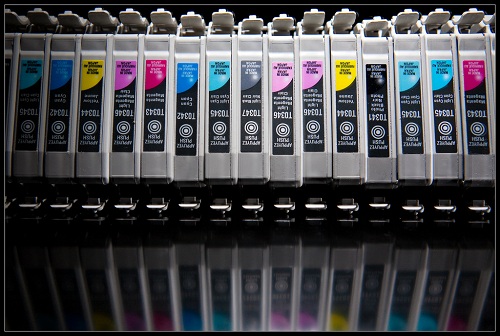Decoding Printer Palette: What Ink Colors Are Used in Printers?
Introduction
Printers play an integral role in our daily lives. But have you ever wondered what ink colors are used in printers? If so, you have arrived at the right place! This article aims to breakdown the various ink colors used in printers and the intriguing process through which they deliver our print jobs. Read on to learn about the primary colors used in printers, the transition from RGB to CMYK, the use of special inks and how to mix them to achieve your desired results.
Understanding the Basics of Printer Inks
The cohesion of printed content largely depends on printer inks. These vital elements dictate both the clarity and durability of printed materials. Whether showcasing your favorite photos or preparing crucial documents, understanding the basics of printer inks can significantly enhance your printing experience.
- Type of Inks: Printer inks fall into two main categories: dye-based and pigment-based inks.
- *Dye-Based Inks-* Renowned for their rich, vibrant hues, dye-based inks seep into the paper and deliver a stunningly vivid color payoff.
- *Pigment-Based Inks-* These inks sit on top of the paper, granting superior longevity and resistance against sunlight or highlighter marks.
- Primary Colors: Printers predominantly use the CMYK color model. The acronym stands for Cyan (C), Magenta (M), Yellow (Y), and Key or Black (K). These base colors are integral to the printing process and, when used correctly, can mimic virtually any color on the spectrum.
- Color Formation: These primary colors blend in varying proportions to generate an array of shades. Every color plays a unique role. For instance, cyan and yellow mix to form different shades of green.
- RGB to CMYK: Printers convert digital RGB colors to the printable CMYK format. This transition enables accurate reproductions of digitally-created designs.
By grasping these core aspects, you can better understand your printer's inner workings and optimize its capabilities. This knowledge can also guide you in choosing the right printer and ink for your specific needs.
What are the Primary Colors Used in Printers?
The heart of any printing system is the colored inks it uses. The CMYK color model maintains the rule here, encompassing four key ink colors that turn white sheets into vibrant prints. Let's delve into these vital hues:
Cyan: A Power Player in the Print World
- Description: Cyan, a cross between blue and green, is one of the critical members among printer ink colors.
- Role: This color plays a mighty role in generating multiple shades, especially various hues of blues and greens when combined with yellow and black.
Demystifying the Magic of Magenta
- Description: Magenta is a rich pink-purple color and holds a significant position in the ink palette.
- Role: This color works in tandem with cyan and yellow to churn out a broad spectrum of shades. Remarkably, it's responsible for creating variations of purples and reds when mixed with other primary colors.
Yellow: The Bright Spark in Printing
- Description: Yellow, a standout among the primary printer colors due to its brightness, adds a unique touch to the printer's palette.
- Role: Yellow is key to fabricating shades of green in combination with cyan and different hues of orange when paired with magenta.
Black: The Dark Horse of Color Printing
- Description: Black is the foundational color that adds much-needed depth to printing.
- Role: Crucial for producing neutrals and dark tones, black ink intensifies image depth and contrast, making visual elements appear more vibrant and detailed.
How does the Transition from RGB to CMYK Happen?
The process of converting RGB (Red, Green, and Blue) to CMYK (Cyan, Magenta, Yellow, and Black) is a fascinating journey. This transition allows the colorful digital screens to translate accurately into tangible prints.
RGB: The Digital Champ
RGB is the color model used for digital displays, such as computer screens and television sets. It's based on additive color theory where Red, Green, and Blue light are added together to create a broad array of colors.
CMYK: The Print Pro
On the other hand, CMYK, used in printing, uses subtractive color theory. It begins with a blank, usually white paper. The CMYK colors are then applied in varying intensities, "subtracting" or absorbing light from the paper to create different hues.
The Transition: A Not-So-Easy Journey
The conversion from RGB to CMYK can often lead to slight changes in color, explained as:
• RGB has a broader color range or 'gamut' than CMYK. Some RGB colors, notably, highly saturated ones, can't be replicated exactly in print.

• CMYK uses ink, a physical medium, which interacts with light differently than the light emission from digital screens. This often results in prints appearing darker or less vibrant than on screen.
Software Solution
Often, image editing software like Photoshop will handle this conversion automatically, trying to retain as much color accuracy as possible. However, designers can manually adjust the colors to achieve optimum results in print.
The transition from RGB to CMYK is not just a topic of interest for graphic designers or print professionals; having a basic understanding of this process can help anyone get better results from their prints.
What is the Use of Special Inks in Printers?
Beyond the use of primary inks, certain printing tasks demand the integration of special inks. These inks typically serve special applications and are used to create effects that are beyond the scope of the routine CMYK color model.
A Dive into Metallic and Fluorescent Inks
Metallic and fluorescent inks introduce a unique dimension to the world of printing. These special inks are used to create a standout effect or attract attention to particular aspects of a printed piece.
- Metallic Inks: These are designed to mimic the look of precious metals. They provide a shiny, reflective finish that can make printed items appear more luxurious.
- Fluorescent Inks: Known for their vibrant, neon-like colors, these inks are designed to be extremely eye-catching. They are often used when high visibility is needed, such as on safety signs or promotional materials.
Illuminating the Function of White Ink in Printing
White ink holds a pivotal role in the printing process. Although it may sound counterintuitive, particularly as printing is often carried out on white paper, white ink can be fundamental for specific applications, including:

- Printing on Colored or Transparent Material: When printing on materials other than white paper, white ink serves as a base layer to ensure optimal color pop and visibility.
- Creating Lighter Shades: White ink can be combined with other color inks to produce lighter shades, giving designers more options when matching specific color palettes.
- Highlighting Prints: Sometimes, white ink is used for highlighting and embellishing certain parts of a print, adding more depth and artistic effect.
How to Mix Inks for Desired Colors in Printing?
Sometimes, the precise color you need for a print job might not be a primary color or easily achievable through a standard printer's CMYK model. This situation requires a basic understanding of mixing inks to obtain the desired hue. Here's an easy guide on how to mix printer inks to achieve the perfect color match for your prints:
- Understanding the CMYK Model: Start with the basics and familiarize yourself with the CMYK color model (Cyan, Magenta, Yellow, and Black). As primary colors in most printers, they are the building blocks for creating an array of color shades.
- Assess Your Desired Color: Next, thoroughly assess the color you want to achieve. This can involve examining its color components or using a color wheel for reference.
- Experiment: Start mixing inks by combining the necessary color components. For instance, to get a purple shade, you would combine magenta and cyan. At this stage, it's vital to start gradually and adjust accordingly to reach your desired hue.
- Testing: Before starting your print job, do small test prints to ensure the color comes out exactly how you want it on paper.
- Adjustment: Don't be afraid to adjust the ink mixture if results are not as expected. It may take several trials until you achieve the perfect color match.
Following these steps will let you conquer color dynamics and give you the freedom to custom mix inks for that perfect shade, hue, or tint in your prints.
Conclusion
Black is crucial for producing neutral and dark tones. It enhances the depth and contrast in images, making them more vivid and detailed.
Related FAQs about what ink colors are used in printers
Why are Pantone colors significant in the printing industry?
Pantone colors, also known as Pantone Matching System (PMS), are crucial in the printing industry for color standardization. Its comprehensive color system ensures that any particular Pantone color will appear the same across different mediums and materials, guaranteeing consistent branding and design output.
What factors should you consider when selecting printer inks?
When selecting printer inks, it's important to consider print quality, durability, cost-effectiveness, and the compatibility with your printer model. You should also consider the type of printing you do most frequently; for instance, pigment-based inks might be better for longevity while dye-based inks often provide richer colors.
How do different ink colors affect the quality of prints?
Different ink colors play a vital role in achieving superior print quality. The primary colors (CMYK) combine to reproduce a wide range of colors. Colors also impact the print's depth and contrast. For example, black ink intensifies these factors, making visuals more vibrant and detailed.


